 |
 |
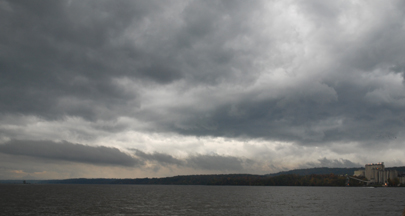
0700 hours
Starting Position: Anchored between Cementon and Duck Cove.
Latitude: 42˚ 08.7' N
Longitude: 073˚ 53.9' W
Day Two of the 2009 Masters Voyage of Discovery.
As dawn breaks on the first full day of our voyage, we see that the skies are still densely overcast. However, the rain has spent itself over the course of the night, and the churning skies above indicate a change in weather. The forecast tells us of a high pressure system moving into the area, which should bring with it crystal clear skies -- and a frost warning.
|
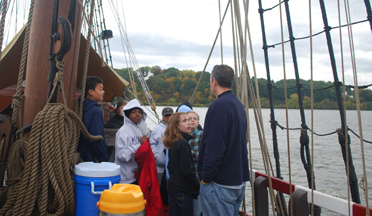
0745 hours
The winds generated by the pressure front should provide us with a fine day of sailing, but we need to get underway as soon as possible to take full advantage of them. As our groggy students make their way on deck, our senior crew have already climbed aloft to unfurl the sails.
|
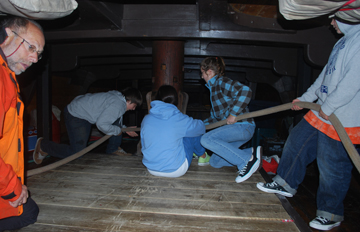
0800 hours
No sooner is the crew mustered than we task them with prepping the anchor rode. Down on the orlop deck, the students are hard at work running the anchor rode (line) around the lower capstan.
|
Mouse over to take
Kees for a spin.
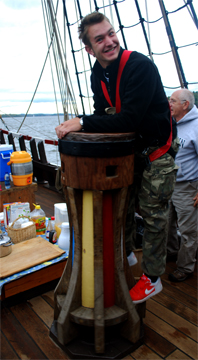 |
Meanwhile, the senior crew is just as hard at work, putting their full weight into the upper capstan.
|
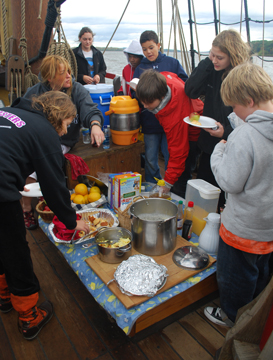
0815 hours
Once we're ready to weigh anchor, we take a break for breakfast. Today it's scrambled eggs and biscuits with sausage gravy, along with alternatives for our vegetarian crew members.
|
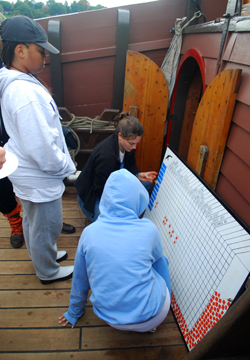
0830 hours
We have a few minutes to spare, so Ms. Laufer introduces the students to the Task Matrix. Isis and Taylor (bundled up in her blue hoodie) are the first crew members to enter in their accomplishments, representing the duties they performed during their watch rotation yesterday afternoon. By the end of the week, the Matrix will be nearly full.
|
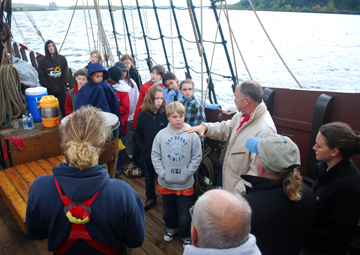
A few moments later, Captain Reynolds convenes a crew meeting to fully explain the complex procedure of weighing anchor, our first major task of the day.
|
Mouse over to walk the capstan.
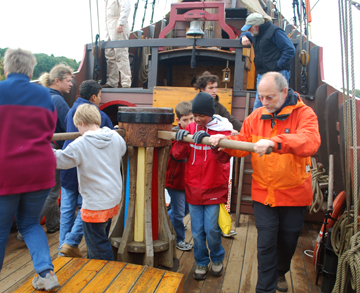 |
0845 hours
Weighing anchor requires the assistance of all hands, divided into three teams. On the weather deck, the capstan team provides the main muscle, using the mechanical advantage granted by the capstan to wind the anchor rode back into the ship.
Ben, Brandon, Jason, and Matt are the first students to walk the capstan.
|
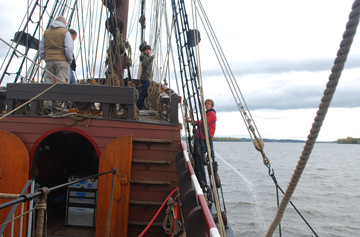
Currently stationed as lookout, Erin has joined the fore deck team. The fore deck team will manually haul the anchor up onto the ship once the capstan team brings it back to the water's surface.
|
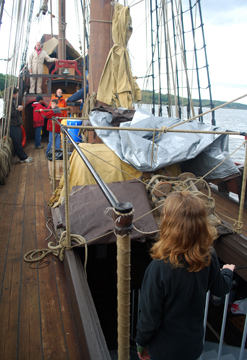
Meanwhile, Grace is acting communicator, relaying messages between Captain Reynolds and our final team...
|
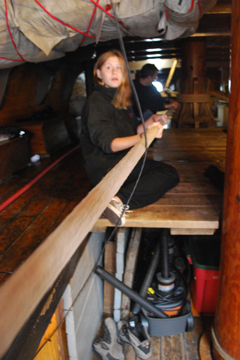
The belowdecks team works on the orlop deck, monitoring the anchor rode as it winds around the lower capstan. One half of the team -- including Sofia here -- is in charge ot preventing the rode from snarling around itself -- an override -- as it passes around the capstan.
|
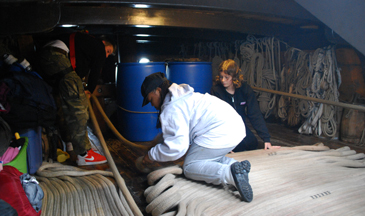
The other component of the belowdecks team are the fakers, who happen to be Abigail and Isis this morning. Working under Mr. Collens' supervision, they neatly fold -- or "fake" -- the anchor rode as it passes back to them after winding its way around the capstan. For his part, Mr. Collens tend the bits, standing ready to make off the anchor rode at a moment's notice as a failsafe precaution.
|
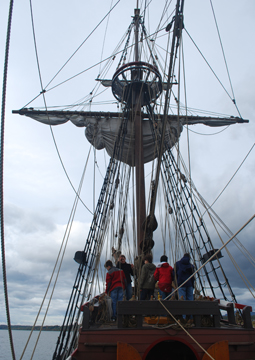
0900 hours
With all hands working together, our first experience with weighing anchor flies by. The crew immediately shifts to the fore and main masts, where they will soon receive their first lessons in sail handling.
|
Mouse over
to set
the main top sail.
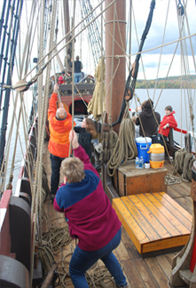 |
0915 hours
We start out by setting the top sails. Although smaller than the courses, they draw on the higher, stronger winds, and thus actually provide relatively more propulsion to the ship.
|
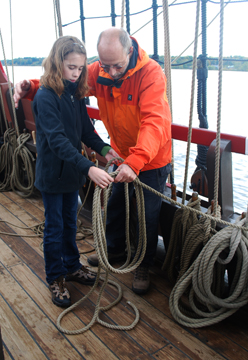 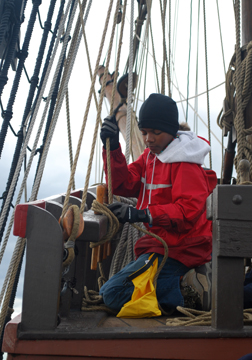
With the sails set and drawing, the students quickly belay and coil their lines to tidy the deck.
|
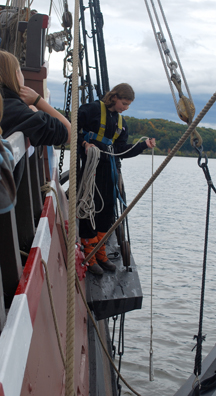
0930 hours
We've chosen to enter treacherous waters today, so we station Abigail on the fore channel to take regular soundings.
|
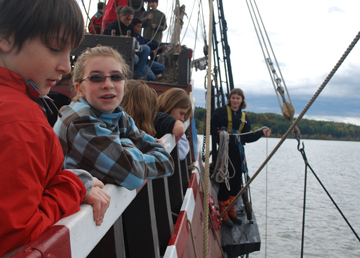
Abby's the first student to be assigned a position over the rail, so she draws an immediate crowd.
|
Mouse over to sound the bottom.
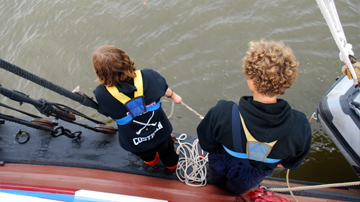 |
With Mr. Berg's guidance, Abigail will spend the rest of the hour slinging the lead; we'll show you why in just a moment.
|
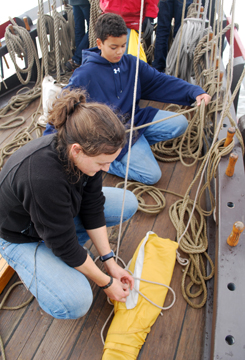
Abigail isn't the only crew member who'll need to stay on her toes, however. While Matt coils lines on the fore deck, his mast captain, Ms. Laufer, runs up the flag of the Province of Holland. Flags aren't just for identification and decoration; they also act as convenient gauges of the wind's direction. Ms. Laufer will need that information to adjust the sails quickly and accurated.
|
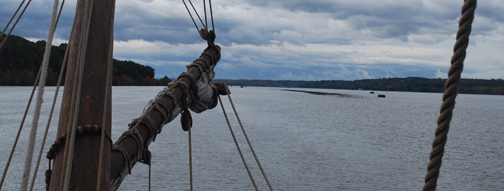
The dire straits now loom before us. That smudge in the middle of the water is a shallow bed of river grasses known, rather logically, as Green Flats. The main channel lies to the west (on the right as we look at it here), and is known as the Malden-on-Hudson Reach, the route all major river traffic follows.
|
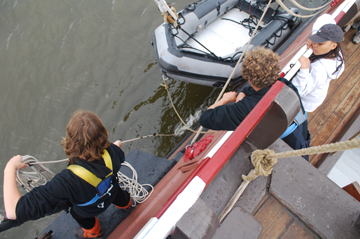
We, however, have chosen to pass to the narrow passage to the east, where a distance of less than the length of the ship can mean the difference between water depths of forty feet or a mere two feet. We've successfully passed through here before, most recently on our journey upriver during the Fall Voyage of Discovery, but can we pull it off again?
|
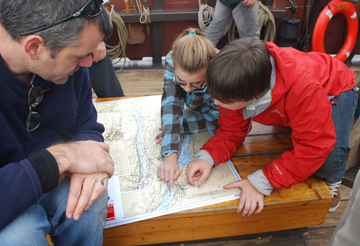
0945 hours
While Isis takes tips from Abigail and Mr. Berg on how to use a lead line, the Masters teachers have Izzy and Dante study a modern river chart to determine our current location.
|
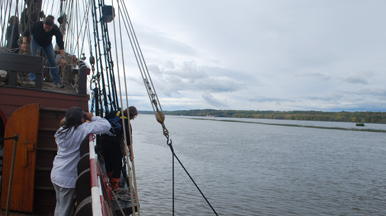
1000 hours
So far, so good; we're about halfway through the channel now. As we've cautiously crept along, we've attracted the curious attention of the large number of duck hunters who've set up their blinds and decoys along the Green Flats. (One of whom was even concerned enough to come out and warn us about the shallow waters ahead.)
|
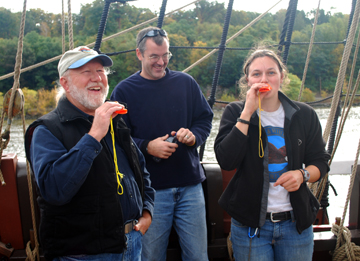
Mr. Hansen and Ms. Laufer decide to risk it and break out their Aquaducks quackers, trying to see if we can attract any more ducks than the hunters.
|
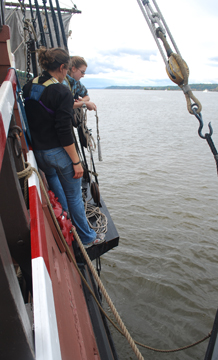
1015 hours
As we near the end of the channel, we've rotated Izzy into the sounder's position. That lead weight is heavier than it looks, and we don't want to wear anyone out.
|
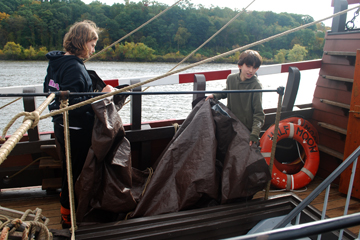
1030 hours
We've successfully navigated the Green Flats and rejoined the main river channel. As if to celebrate, blue skies are starting to break through the clouds above, so we finally take down our tarps.
|
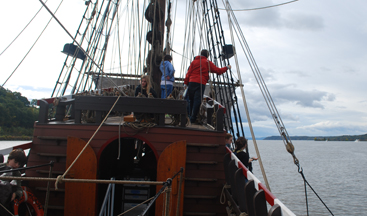
We continue on our way with Taylor at lookout.
|
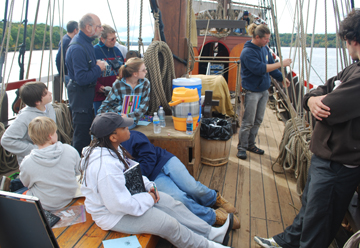
1100 hours
As the morning continues, ship's bosun Van Grondelle gathers the off-duty Starboard Watch for a more formal lesson in sail handling. The students take notes as he diagrams the lines and uses of the running rigging. After the shift change, he'll give the same lesson to Port Watch. |
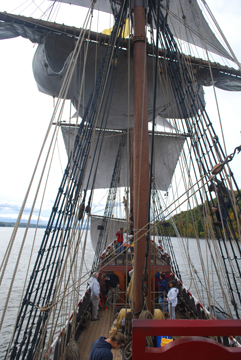
1115 hours
As we continue on our way toward Kingston, we continue to explore the Hudson River's seldom-used side channels. Our new sail teams get plenty of practice as we frequently brace to the winds.
|
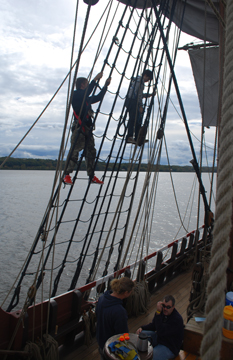
In the meantime, the students have the opportunity to pursue personal interests. Many of them are particularly eager to climb the rig, so senior crew members escort them aloft throughout the day.
|
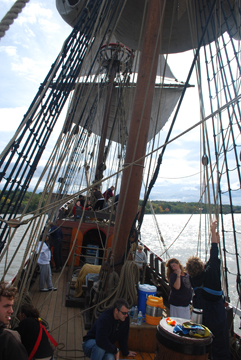
1130 hours
Our explorations of the side channels bring us close to repeating history. You might remember from yesterday's log that on September 24th, 1609, the day after setting out from the Albany region, the Half Moon ran aground on an oozy shoal. In view of the Kingston-Rhinecliff Bridge, just south of a shoal known as the Hogs Neck, we momentarily slide into the ooze while transferring from one channel to the next. (Sadly, with the constant shifting of silt in the river's current, we can't honestly claim to have struck the exact same shoal.) Our crew leaps into action, sharply bracing the sails to have the stiff northerly wind push us back off. Within a few minutes, we heel away and are once again on our way.
|
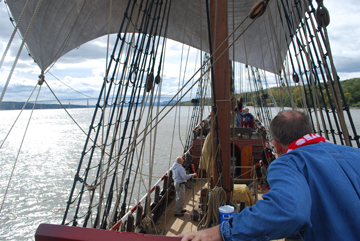
1200 hours
As we close in on Kingston, our explorations of the Hudson's seldom-navigated waters comes to a close.
|
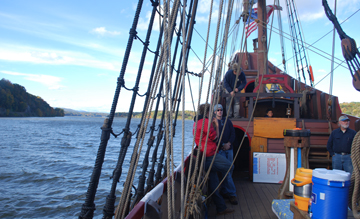
1530 hours
The next few hours pass quietly under sail. By the time we round a bend and come into view of Poughkeepsie, azure skies have finally pushed away the last of the dark clouds.
|
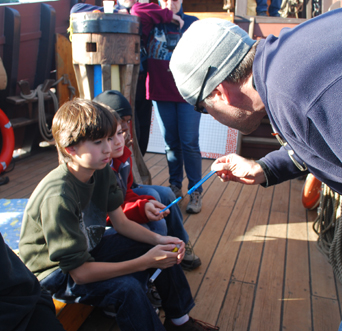
1630 hours
During the afternoon, the Masters faculty officially begins the students' orientation to river science by introducing them to the instruments they'll be using to monitor the Deck Log.
|
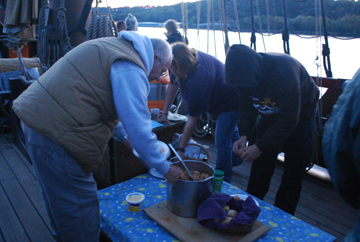
1845 hours
Ms. Daley serves pasta and chicken for dinner as the sun sinks behind the western shore.
|
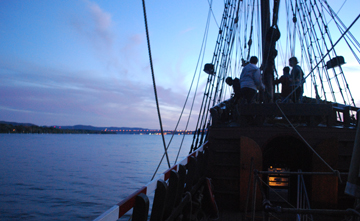
However, in the dwindling dusk, we see the lights of the Newburgh-Beacon Bridge beckoning before us. Just as the day is ending, so too is our day's journey reaching its conclusion: Newburgh Bay will be our destination for the night.
|
Mouse over to run out the anchor rode.
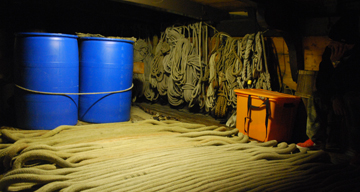 |
1945 hours
Shortly after the ship passes under the Newburgh-Beacon Bridge, Captain Reynolds gives the command to "Let fall!" and the anchor once again plunges to the bottom. On the orlop deck, Mr. Collens maintains a safe distance as the anchor rode runs out through the hawsehole. Can you spot him in the shadows?
Ending Position: Anchored south of the Newburgh-Beacon Bridge.
Latitude: 41˚ 30.8' N
Longitude: 073˚ 59.5' W
|
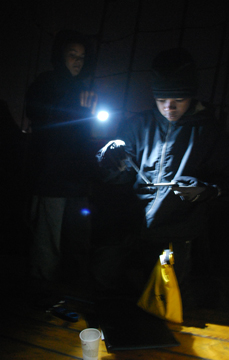
2000 hours
With the ship secure, the captain concludes a long day of travel with our nightly Anchor Watch briefing. With a chill already falling over Newburgh Bay, the students settle into their bunks before lights out.
2000 hours
Anchor Watch continues through the night under the bright starscape of a crystal-clear night sky. In addition to their standard duties, the Anchor Watch members also track the air temperature and relative humidity through the night -- as Matt and Jason are doing here, during their chilly 0300-0400 shift.
Next Time: Bright Sun and Highlands.
|
Robert Juet's Journal
A strong southerly wind prevents the Halve Maen from continuing downriver for two days, so the crew spends their downtime exploring the western shore while the ship remains at anchor, most likely a somewhere relatively near the site of modern Poughkeepsie. This isn't simple shore leave, however; this is an expedition to evaluate the natural resources of the Hudson River Valley. They are greatly impressed by what they find: fertile soil for crops and the wood and stone needed to build ships and settlements. In these observations lie the origins of the New Netherland Colony and all that would come after.
The next day, a shore party (led by the anonymous first mate and ship's carpenter) heads inland to collect wood -- most likely for use as firewood, the ever-dwindling fuel source for the galley cookbox. During the morning, a party of Mahicans returns to the ship. This group is led by the same elder who previously spent a night onboard the Halve Maen a few days earlier, when the ship was near the modern Port of Albany. Having established a friendly rapport with Captain Hudson, the elder has now returned with friends. Hudson and the Mahicans share lunch and exchange gifts, and when the Mahicans depart, they invite the crew to join them at their home, some six miles farther downriver.
On September 25th & 26th, 1609:
The fiue and twentieth was faire weather, and the wind at South a stiffe gale. We rode still, and went on Land to walke on the West side of the Riuer, and found good ground for Corne, and other Garden herbs, with great store of goodly Oakes, and Wal-nut trees, and Chest-nut trees, Ewe trees, and trees of sweet wood in great abundance, and great store of Slate for houses, and other good stones.
The sixe and twentieth was faire weather, and the wind at South a stiff gale, wee rode still. In the morning our Carpenter went on Land with our Masters Mate, and foure more of our companie to cut wood. This morning, two Canoes came vp the Riuer from the place where we first found louing people, and in one of them was the old man that had lyen aboord of vs at the other place. He brought another old man with him, which brought more stropes of Beades, and gaue them to our Master, and shewed him all the Countrey there about, as though it were at his command. So he made the two old men dine with him, and the old mans wife: for they brought two old women, and two young maidens of the age of sixteene or seuenteene yeeres with them, who behaued themselues very modestly. Our Master gaue one of the old men a Knife, and they gave him and vs Tabacco. And at one of the clcoke they departed downe the Riuer, making signes that wee should come downe to them; for wee were within two leagues of the place where they dwelt.
-- Robert Juet's Journal.
|
|
|



